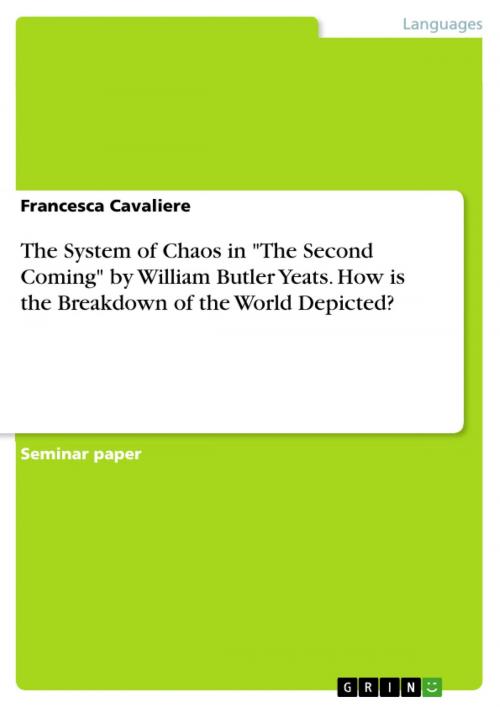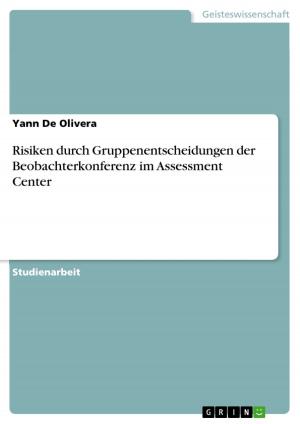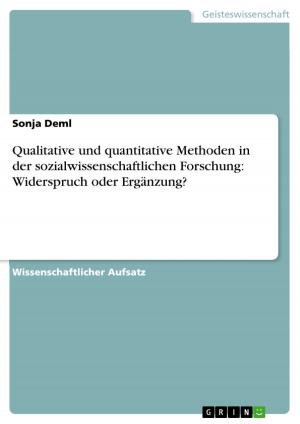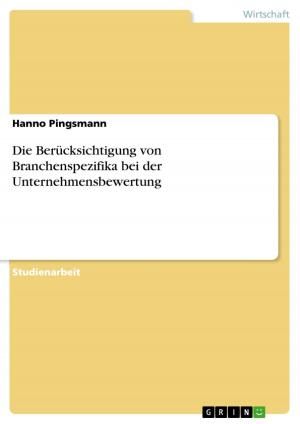The System of Chaos in 'The Second Coming' by William Butler Yeats. How is the Breakdown of the World Depicted?
Fiction & Literature, Literary Theory & Criticism, British| Author: | Francesca Cavaliere | ISBN: | 9783668174443 |
| Publisher: | GRIN Verlag | Publication: | March 15, 2016 |
| Imprint: | GRIN Verlag | Language: | English |
| Author: | Francesca Cavaliere |
| ISBN: | 9783668174443 |
| Publisher: | GRIN Verlag |
| Publication: | March 15, 2016 |
| Imprint: | GRIN Verlag |
| Language: | English |
Seminar paper from the year 2011 in the subject English - Literature, Works, grade: 1,0, University of Potsdam (Anglistik Literatur), course: Symbolism and Modernism in British Poetry, language: English, abstract: 'The Second Coming' was composed by the Irish poet William Butler Yeats in 1919, in the aftermath of the First World War and was first published in November 1920. The present paper examines what enables the speaker to envision the Second Coming and how his vision is linked to the Biblical model. How is the breakdown of the world depicted and what are revealed to be its possible causes. The poem's title 'The Second Coming' makes reference to the Biblical reappearance of Christ, as prophesied in Matthew 24 and the Book of Revelation of St. John in the New Testament. According to Christian belief, Christ will return to conquer Satan and the forces of evil, before presiding over a thousand-year reign of peace on Earth. True to the Biblical pattern, the speaker of the poem envisions the breakdown of the present state of the world and the dawn of a new age. He adds, however, a sinister twist to the idea of the Second Coming, suggesting that the return of Christ might just as well become the arrival of the Antichrist. I will consequently go on to conclude that the poem presents the world as a perfectly balanced system of two opposing forces or principles such as: centrifugal vs. centripetal force in physics, democracy vs. aristocracy in politics, Christ vs. Antichrist in religion etc.. Whenever this opposition is completely cancelled, chaos will be its consequence. All this is, however not to say that chaos sounds for the final phase of existence. On the contrary, it denotes but a phase of transition, as the world is subject to constant change and history moves in a cyclic pattern. Chaos can hence be described as being part of a greater system. I will proceed in a more or less chronological order starting with the 1st stanza where the speaker describes the present state of the world. The focus will be put here on the omnipresence of chaos and its relation with the laws of physics, political systems and the divine judgement. The second main part of the paper will deal with the 2nd stanza which presents the speaker's future vision of the Second Coming. The detailed description of the 'Antichrist' in the poem will be compared to the depiction of Christ in the Bible. In the last stanza the speaker looks back in history, as if to back up his prophetic vision of the breakdown of the Christian era.
Seminar paper from the year 2011 in the subject English - Literature, Works, grade: 1,0, University of Potsdam (Anglistik Literatur), course: Symbolism and Modernism in British Poetry, language: English, abstract: 'The Second Coming' was composed by the Irish poet William Butler Yeats in 1919, in the aftermath of the First World War and was first published in November 1920. The present paper examines what enables the speaker to envision the Second Coming and how his vision is linked to the Biblical model. How is the breakdown of the world depicted and what are revealed to be its possible causes. The poem's title 'The Second Coming' makes reference to the Biblical reappearance of Christ, as prophesied in Matthew 24 and the Book of Revelation of St. John in the New Testament. According to Christian belief, Christ will return to conquer Satan and the forces of evil, before presiding over a thousand-year reign of peace on Earth. True to the Biblical pattern, the speaker of the poem envisions the breakdown of the present state of the world and the dawn of a new age. He adds, however, a sinister twist to the idea of the Second Coming, suggesting that the return of Christ might just as well become the arrival of the Antichrist. I will consequently go on to conclude that the poem presents the world as a perfectly balanced system of two opposing forces or principles such as: centrifugal vs. centripetal force in physics, democracy vs. aristocracy in politics, Christ vs. Antichrist in religion etc.. Whenever this opposition is completely cancelled, chaos will be its consequence. All this is, however not to say that chaos sounds for the final phase of existence. On the contrary, it denotes but a phase of transition, as the world is subject to constant change and history moves in a cyclic pattern. Chaos can hence be described as being part of a greater system. I will proceed in a more or less chronological order starting with the 1st stanza where the speaker describes the present state of the world. The focus will be put here on the omnipresence of chaos and its relation with the laws of physics, political systems and the divine judgement. The second main part of the paper will deal with the 2nd stanza which presents the speaker's future vision of the Second Coming. The detailed description of the 'Antichrist' in the poem will be compared to the depiction of Christ in the Bible. In the last stanza the speaker looks back in history, as if to back up his prophetic vision of the breakdown of the Christian era.















